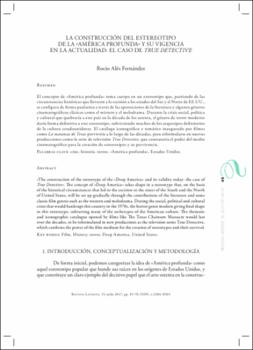La construcción del estereotipo de la «América profunda» y su vigencia en la actualidad: el caso de True Detective
Autor
Alés Fernández, RocioFecha
2017Resumen
El concepto de »América profunda» toma cuerpo en un estereotipo que, partiendo de las
circunstancias históricas que llevaron a la escisión a los estados del Sur y el Norte de EE.UU.,
se configura de forma paulatina a través de las aportaciones de la literatura y algunos géneros
cinematográficos clásicos como el wéstern y el melodrama. Durante la crisis social, política
y cultural que quebraría a este país en la década de los setenta, el género de terror moderno
daría forma definitiva a este estereotipo, subvirtiendo muchos de los arquetipos definitorios
de la cultura estadounidense. El catálogo iconográfico y temático inaugurado por filmes
como La matanza de Texas perviviría a lo largo de las décadas, para reformularse en nuevas
producciones como la serie de televisión True Detective, que constataría el poder del medio
cinematográfico para la creación de estereotipos y su pervivencia. The concept of «Deep America» takes shape in a stereotype that, on the basis
of the historical circumstances that led to the excision to the states of the South and the North
of United States, will be set up gradually through the contributions of the literature and some
classic film genres such as the western and melodrama. During the social, political and cultural
crisis that would bankrupt this country in the 1970s, the horror genre modern giving final shape
to this stereotype, subverting many of the archetypes of the American culture. The thematic
and iconographic catalogue opened by films like The Texas Chainsaw Massacre would last
over the decades, to be reformulated in new productions as the television series True Detective,
which confirms the power of the film medium for the creation of stereotypes and their survival.





